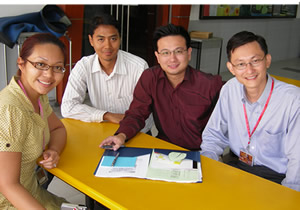Why Singapore’s English Teachers Should Embrace Singlish, Not Fight It
Is it time for Singaporean educators to embrace Singlish as a legitimate learning tool? What the Research […]
Read More
SimCity in the classroom? Why not, said a team of mathematics teachers from Coral Secondary School. Since computer games already pervade our students’ personal lives, they thought it might be worthwhile to introduce it into the classroom.
Can playing computer games really help to improve the learning of mathematics? Well, that’s what team members Loo Liat Siang, Dennis Teo, Doris Tan and Rafi bin Mohd Rais wanted to find out. So they carried out a pilot action research study to examine the effects of SimCityTM 4 on the learning of problem-solving abilities in mathematics.
 Noting that students nowadays engage in more technology-based pastimes, such as playing video games, online chatting and blogging, the research team sought to capitalise on these pastimes to develop their students’ problem-solving skills.
Noting that students nowadays engage in more technology-based pastimes, such as playing video games, online chatting and blogging, the research team sought to capitalise on these pastimes to develop their students’ problem-solving skills.
Their review of the literature had also turned up research on how computer simulation can motivate and promote interest in learning, and make learning more fun (Aldrich, 2004). Therefore, this seemed like a good way to make the learning of mathematics more interesting and relevant to real life.
“It’s a different way to teach mathematics,” explained Dennis, who is the project team leader. “In the past, students can just sit still and listen to the teacher teaching, but nowadays students are not like that. We need to engage them in much more innovative ways. So using computer games is just one way that we explore to teach maths in a different way.”
The teachers believed this new teaching method was also in line with the call to “Teach Less, Learn More”, to better engage students in their learning, beyond the traditional method information transmission.
A small sample of 15 Secondary 3 students from a Normal (Academic) [N(A)] class were selected to participate in this study. These 5 girls and 10 boys were of mixed mathematical ability.
“One of the reasons why we introduced it for N(A) was to really get the students more interested in learning mathematics,” explained Mr Loo, who heads the mathematics department. “So we introduced this game to make them more motivated.”
These students were asked to participate in a 4-day enrichment programme held in October 2005, after their year-end examinations.
The team took 4 months to design and trial a lesson package, which they named “Go Build a City”. It incorporated the use of SimCity 4, a city-construction simulation game, as well as some mathematical content.
SimCity 4 was chosen because it met the four key ingredients of effective game design proposed by Aldrich (2004):
Said Mr Loo, “When we designed the package, we are very clear about our objectives. We wanted students to learn the problem-solving steps,” referring to a 4-step problem-solving framework in the mathematics curriculum. “We also factored in mathematical content, that is, taxation and arithmetic problems, which provided the contexts to apply the problem-solving steps.”
 A pre-test comprising mathematical problem-solving questions was administered on the first day of the programme. On the second day, students were given a realistic scenario – as the mayor, lead in the rebuilding of a city that had been razed by a natural catastrophe – and taught how to play the game.
A pre-test comprising mathematical problem-solving questions was administered on the first day of the programme. On the second day, students were given a realistic scenario – as the mayor, lead in the rebuilding of a city that had been razed by a natural catastrophe – and taught how to play the game.
Using scenarios from the game, the problem-solving steps and the concept of taxation were imparted to students through direct teacher instruction on Day 3.
On the last day, students were challenged to see who could build a city to generate the highest profit. A post-test was administered at the end.
The students were observed by two team members throughout the intervention. The team also conducted focus group interviews and two convergent interviews to obtain more information from some of the participants. A rigorous process of data analysis was carried out to validate the team’s findings.
The team identified five key problem-solving effects:
The team found that the first two effects have translated into improved problem-solving abilities, as post-test scores have generally increased by 4 points, and the t-test has shown the increase to be statistically significant.
 In addition, the team also found a significant correlation between in-game profit and improvement in test scores, which suggests a link between playing the game and improvement in problem-solving abilities.
In addition, the team also found a significant correlation between in-game profit and improvement in test scores, which suggests a link between playing the game and improvement in problem-solving abilities.
The team was particularly surprised to discover the latter three effects, as they were not central to the teaching and learning of mathematical problem solving. Nonetheless, they were important to help individuals function effectively in the future workplace.
“When we were doing our interviews with the students, what they said provided evidence that there are other skills that they picked up from the game, other than academic knowledge and skills,” noted Dennis. “For instance, a few students said that after playing the game, they were able to manage their finances better. The game helped them to think ahead and make decisions wisely on the things to spend on.”
“The students have learnt important lifeskills but they didn’t realise it until we started questioning them deeper, especially during the convergent interviews,” added Rafi. “Maybe that was because some students had pre-conceived notions about computer gaming – that games are a waste of time or addictive. But in the end, we found out that students had learned quite a bit.”
While a larger scale study is needed to validate the findings, the preliminary findings are encouraging, showing that the use of computer simulation games is a potentially effective methodology for the teaching and learning of mathematics.
These teachers hope that their findings would encourage further studies into the use of computer simulation games in the teaching of mathematics as well as in other subjects.
“I think that’s the way to go,” said Mr Loo. “In the workplace, people are already using simulation for training purposes, and students nowadays are so in tune with such things, so it should be something they are familiar with and they are passionate about. So I think this is something we can tap on to bring about greater student engagement.”
This project was one of many that teachers at Coral Secondary School (now merged with Siglap Secondary School to become Meridian Secondary School) have engaged in.
Reference
Aldrich, C. (2004). Do you want fries with that e-learning? San Francisco: Pfeiffer.